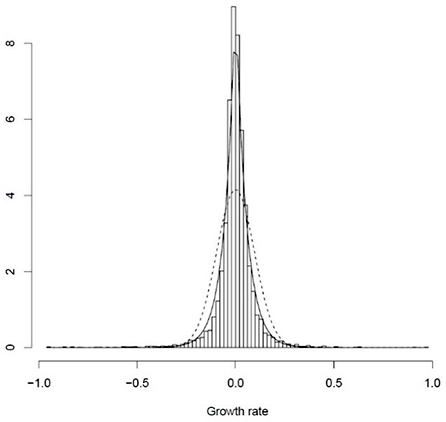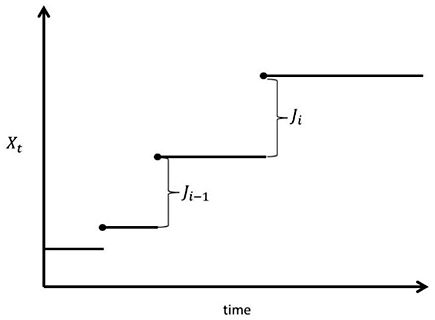Many people talk about "using innovation to promote corporate growth and further revitalize the Japanese economy (Note 1)." The word "innovation" has been used frequently in newspapers and television shows alike in recent years. Innovation is also a key concept in academic research and seen as a source of corporate growth. Empirical debate of this theme typically takes the approach of statistically examining the relationship between research and development (R&D) investment and corporate growth. In this article, I adopt a slightly different perspective with emphasis on the "distribution" of corporate growth rates.
Distribution of corporate growth rates
Individual companies have individual circumstances with a variety of reasons for achieving growth. Yet, at the same time, it is a known fact that plotting the distribution of corporate growth rates shows a distinctive statistical characteristic, which is observed in just about any country and industry. Figure 1 is a histogram showing the growth rates of Japan's listed companies. Compared to the normal distribution (broken line), there is a sharp spike in the middle with fatter tails. Since the spike corresponds to a growth rate of around zero, the histogram indicates little business expansion or contraction for most companies. At the same time, the fatter tails indicate higher probability in large growth fluctuations compared to the level anticipated in the normal distribution. This means that when companies expand or contract, the scale of expansion or contraction is substantial. Simply put, when they change, it is done dramatically.

Of course, individual companies are not worried about such distribution data. They make their corporate efforts according to the business conditions they face. Yet, once their data are aggregated, the result shows a characteristic distribution pattern. What kind of mechanism is at play in creating such distribution? In fact, combining this distribution with an observed fact that the proportional rate of growth of a company is independent of its size (Gibrat's Law) allows us to identify the process of corporate growth, attributable to this distribution pattern (Note 2). This growth process is illustrated by a series of jumps as shown in Figure 2. There is almost no change until sudden growth kicks in, followed by another period of stagnation until the next sudden growth, and so on. In other words, corporate growth is triggered by a sudden, significant success, rather than by a series of small successes. In principle, there is no telling when a company makes this sudden leap forward. However, observation of the growth rate distribution leads to the conclusion that companies attain growth in a series of major successes.

Radical innovation
As explained earlier, there is a close correlation between corporate growth and innovation. In associating the aforementioned debate on growth process with debate on innovation, it is useful to adopt the concepts of "radical innovation" and "incremental innovation." Radical innovation is a type of innovation that turns a conventional market structure or corporate superiority upside down or creates a completely new market. In contrast, incremental innovation refers to incremental improvement of existing products.
Which of these two opposite concepts is more important for corporate growth? Considering the aforementioned process of corporate growth, radical innovation plays a decisively important role in corporate growth. We must conclude that it is almost unthinkable for a company to evolve into a large corporation by repeating incremental innovations. The success or otherwise of radical innovation holds the key to a company's fate. Once a competitor forges ahead with radical innovation, there is very little that incremental innovation could do.
However, radical innovation faces various difficulties (Note 3). It requires significant time and cost despite involving major risks and an unclear outlook. In addition, if a new product based on innovation competes against the same company's existing product, such innovation would meet resistance from those involved in the existing product. Lack of understanding about innovation within the company creates the need to persuade senior management to authorize funding for the project. Attaining radical innovation requires a number of hurdles that must be cleared, including but not limited to purely technological challenge for bringing the project to a success.
Those who have overcome such difficulties to achieve radical innovation undoubtedly are a true inspiration. Their story might be made into a television drama or movie. Yet, we must not simply sit and watch it as entertainment. The conclusion that radical innovation is a decisively important factor in corporate growth has been drawn from distribution data observed in reality. In other words, it is not an exception but a reality that is occurring in front of our eyes. That is something that companies must take on for their future growth.
Conclusion
When there is discussion about promoting innovation, we often talk about the need to develop "creative" human resources who can "think outside the box" (Note 4). As radical innovation is all about overturning conventional norms, those who develop it should not be bound by conventions. Yet, there are not very many people who embrace this notion and put it into practice. Many see it as a slogan with no substance. When faced with "conventional" human resources who consistently make returns, albeit small, and human resources who are radically ambitious and too "unconventional" with little to no prospect of returns, it is not exactly easy to value the latter. However, the need for "unconventional" human resources is a matter of reality, rather than an idealistic concept, as radical innovation is the only decisive factor of significance.


